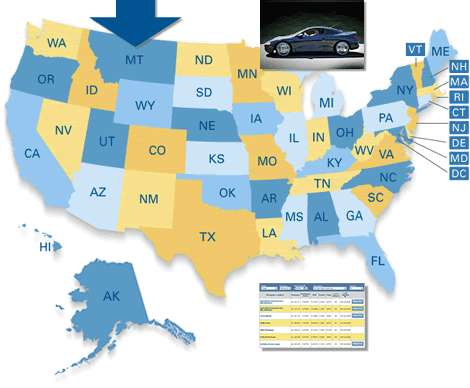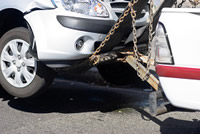Auto Insurance: How Much to Buy?
by Amy Lillard
Determining how much auto insurance you should buy is a matter of looking at your assets and needs, but also state regulations. Many states require certain forms of insurance, along with payment levels. To learn how much you must buy and how much you should buy, we analyze each kind of insurance.
Bodily Injury Liability
This coverage, required in most states, compensates the driver of the other car and its passengers and covers the people within your own car. The idea is to protect against lawsuits. Buy bodily injury liability, and you'll see two different designations. If you buy bodily injury worth $100,000/$300,000, each of the people injured can be compensated $100,000. However, a limit is imposed, in this case up to $300,000 per accident.
The more assets you have, the more protection you need. The amount you'll pay a month will depend on the area in which you live, and the frequency of bodily injury in that area.
Property Damage Liability
This coverage pays for the repair and replacement of the other driver's car or property. States may require this insurance, often at a minimum of $5,000. Consider the potential cost of other vehicles on the road, and the costs to repair them in the case of an accident. This coverage is therefore no area to skimp. A minimum of $50,000 for each vehicle you own should be purchased.
Personal Injury Protection
This coverage takes care of the medical and funeral costs associated with an accident. But if you already have health, life and disability policies, you may already be covered. You can opt out of this auto coverage.
Uninsured or Underinsured Motorist
More and more, this coverage is essential, and mandated by some states. A $100,000 policy charges cheap premiums, and covers medical nd funeral costs for you nd your family in the case of injury from an uninsured driver.
Collision and Comprehensive
This is the area where you should up the deductible to the highest amount you can, saving you money on premiums nad protectign you in case of accident. Collision reimburses you for the full cost of repairs or replacement of your car after an accident. Comprehensive covers you in the event your car is stolen or damaged by natural disaster or vandalism.
New and Used Auto Loan Rates
Choose Your State Below

Start by selecting your state
Consider this when determining amounts. This coverage is requird on most lease contracts, and essential for expensive cars. But for other cars, it may not be necessary. The amount you'll receive from insurance is the Kelley Blue Book value, which declines with your car's age. If the cost of your collision and comprehensive is more than 10% of your car's Blue Book value, It may make more sense to drop this coverage.
To see what your state requires in terms of coverage, consult the following chart. Under Liability Limits, the numbers are as follows: minimum bodily injury liability amount for one person, minimum bodily injury liability for all people injured, and minimum property damage liability.
State |
Liability limits |
Personal Injury Protection required? |
Uninsured/Underinsured motorist coverage required? |
|---|---|---|---|
|
Alabama |
20/40/10 |
No |
No |
|
Alaska |
50/100/25 |
No |
No |
|
Arizona |
15/30/10 |
No |
No |
|
Arkansas |
25/50/15 |
No |
No |
|
California |
15/30/5 |
No |
No |
|
Colorado |
25/50/15 |
Yes |
No |
|
Connecticut |
20/40/10 |
No |
Yes |
|
Delaware |
15/30/5 |
Yes |
No |
|
|
25/50/10 |
No |
Yes |
|
Florida |
10/20/10 |
Yes |
No |
|
Georgia |
25/50/25 |
No |
No |
|
Hawaii |
20/40/10 |
Yes |
No |
|
Idaho |
25/50/15 |
No |
No |
|
Illinois |
20/40/15 |
No |
Yes |
|
Indiana |
25/50/10 |
No |
No |
|
Iowa |
20/40/15 |
No |
No |
|
Kansas |
25/50/10 |
Yes |
Yes |
|
Kentucky |
25/50/10 |
Yes |
No |
|
Louisiana |
10/20/10 |
No |
No |
|
Maine |
50/100/25 |
No |
Yes |
|
Maryland |
20/40/15 |
Yes |
Yes |
|
Massachusetts |
20/40/5 |
Yes |
Yes |
|
Michigan |
20/40/10 |
Yes |
No |
|
Minnesota |
30/60/10 |
Yes |
Yes |
|
Mississippi |
10/20/5 |
No |
No |
|
Missouri |
25/50/10 |
No |
Yes |
|
Montana |
25/50/10 |
No |
No |
|
Nebraska |
25/50/25 |
No |
No |
|
Nevada |
15/30/10 |
No |
No |
|
New Hampshire |
Not required 25/50/25 |
No |
Yes |
|
New Jersey |
15/30/5 |
Yes |
No |
|
New Mexico |
25/50/10 |
No |
No |
|
New York |
25/50/10 |
Yes |
Yes |
|
North Carolina |
30/60/25 |
No |
No |
|
North Dakota |
25/50/25 |
Yes |
Yes |
|
Ohio |
12.5/25/7.5 |
No |
No |
|
Oklahoma |
10/20/10 |
No |
No |
|
Oregon |
25/50/10 |
Yes |
Yes |
|
Pennsylvania |
15/30/5 |
No |
No |
|
Rhode Island |
25/50/25 |
No |
Yes |
|
South Carolina |
Not required 15/30/10 |
No |
Yes |
|
South Dakota |
25/50/25 |
No |
Yes |
|
Tennessee |
Not required 25/50/10 |
No |
No |
|
20/40/15 |
No |
No |
|
|
Utah |
25/50/15 |
Yes |
No |
|
Vermont |
25/50/10 |
No |
Yes |
|
Virginia |
25/50/20 |
No |
Yes |
|
Washington |
25/50/10 |
No |
No |
|
West Virginia |
20/40/10 |
No |
Yes |
|
Wisconsin |
Not required 25/50/10 |
No |
Yes |
|
Wyoming |
25/50/20 |
No |
No |
To learn more about auto insurance, read our continuing series, including articles on common types of coverage, choosing the best plan, filing a claim, and more.
Please do additonal research whenever making decisions about auto insurance or any other financial decisions. The information contained on this website is provided as a supplemental educational resource. Readers having legal, financial or tax questions are urged to obtain advice from their professional financial, legal or tax advisors. While the aforementioned information has been collected from a variety of sources deemed reliable, it is not guaranteed and should be independently verified.
Other Articles:
Auto Loans Advice: New Cars & Used Cars
Car Buying vs Car Leasing
Guideline for Purchasing Life Insurance
Product Warranties
New and Used Auto Loan Rates
Choose Your State Below

Start by selecting your state

Life Insurance
- Term, Whole, Universal, Varialble Life Insurance
- Guidelines for Purchasing Life Insurance
- Life Insurance: Finding the Best Rates
- Life Insurance Explained: Types and Coverage

Medical Insurance
- Health Insurance Basics
- Healthcare Costs and Retirement
- Critical Flaws in HealthCare
- Disability Insurance
- Tips on Buying Long Term Care Insurance
General Insurance Articles

Homeowners Insurance
- Homeowners Insurance Premiums Policy
- Homeowners Insurance: Filing a Claim
- Punxsutawney Phil's forecast-homeowners insurance rates
- Homeowners Insurance Costly Trends
- Home Insurance Costs on the Rise, Coverage Options Decrease
- Homeowners Insurance: The Special Policy for Condo Owners
- Homeowners Insurance College Students Coverage
- Underinsured Homeowners
- Beyond Homeowners Insurance: Coverage for Renters
- What Home Owners Insurance Do You Need? Tips for the Best
- Home Insurance Quotes: Types of Home Owners Insurance
- Home Insurance: How are Insurance Quotes Determined?
- Homeowners Insurance: Finding the Best Quotes


Auto Insurance

- Hitting the brakes on auto insurance costs
- Car Insurance Quotes: Discovering best deals
- Car Ins Quotes: What Factors Determine Rates
- Auto Insurance Quotes and Policies: Commonly Used Terms
- Shopping Prep: What You'll Need to Obtain Car Insurance Quotes
- Auto Insurance Terms & Descriptions
- Understanding Your Auto Insurance Quotes: The 7 Types of Car Insurance
- Auto Insurance - Best Plan for You
- How much Car Insurance to buy
- Need to Know Auto Ins Policy
- Automobile Insurance Settlement Advice
- Managing Auto Insurance: What to Do After an Accident
- Filing a Car Insurance Claim: Steps to Follow after an Accident
- Auto Insurance Steps to Filing a Claim
- Tips - Reducing your Auto Insurance Expenses
- Driving a Hard Bargain
- Slow Down Drive Safely
- Cheapest & Most Expensive Vehicles to Insure
